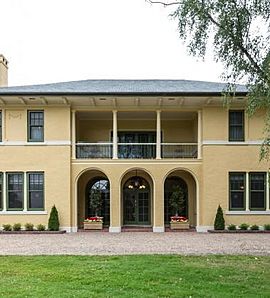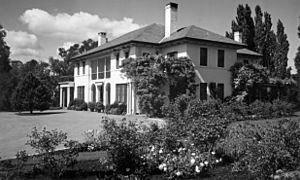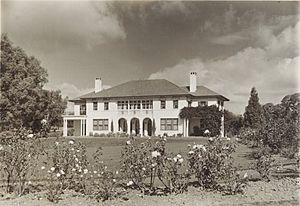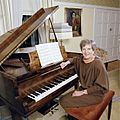The Lodge (Australia) facts for kids
Quick facts for kids The Lodge |
|
|---|---|

Facade of The Lodge
|
|
| General information | |
| Type | Official residence |
| Architectural style | Georgian revival |
| Address | 5 Adelaide Avenue, Deakin, Australian Capital Territory |
| Country | Australia |
| Coordinates | 35°18′39″S 149°07′00″E / 35.310818°S 149.116547°E |
| Current tenants | Prime Minister Scott Morrison, when in Canberra |
| Construction started | 1926 |
| Completed | 1927 |
| Design and construction | |
| Architect |
|
| Official name: The Lodge, 5 Adelaide Av, Deakin, ACT, Australia | |
| Type: | Listed place |
| Criteria: | A., B., C., D., E., F., G., H. |
| Designated: | 22 June 2004 |
| Reference #: | 105452 |
The Lodge is the main home for the Prime Minister of Australia in Canberra, Australia's capital city. You can find it at 5 Adelaide Avenue in Deakin, not far from Parliament House. It's one of two official homes for the Prime Minister; the other is Kirribilli House in Sydney.
The Lodge was finished in 1927. It was built in the Georgian revival style. Over the years, it has been updated many times. It wasn't meant to be a permanent home at first. Some prime ministers have even chosen to live somewhere else during their time in office.
Contents
History of The Lodge
The Lodge is a large house with 40 rooms. It is built in the Australian Georgian revival style. It sits on a big piece of land, about 18,000 square metres (4.4 acres), with beautiful gardens. No one knows for sure how it got its name.
It was first built as a temporary home for the Prime Minister. The idea was that a bigger, more important home would be built later. The original "Prime Minister's cottage" was built between 1926 and 1927. It cost about £28,319, which would be around $2.3 million AUD today. This cost included the gardens, a tennis court, a croquet lawn, and all the furniture.
The architects who designed The Lodge were Percy A. Oakley and Stanley T. Parkes. J. G. Taylor was the builder. Ruth Lane Poole was in charge of the inside design and furniture. The Lodge was supposed to be one of three official homes. The other two were for the leaders of the Parliament of Australia, but they were never built.
Prime Ministers who lived at The Lodge
The first Prime Minister to live in The Lodge was Stanley Bruce. He and his wife moved in on May 4, 1927. This was just five days before the official opening of the Provisional Parliament House.
Not all Prime Ministers have lived at The Lodge. For example:
- James Scullin (1929–32) thought running The Lodge was too expensive. He and his wife stayed at the Hotel Canberra instead.
- Earle Page (1939), Frank Forde (1945), and John McEwen (1967–68) were caretaker prime ministers. They took over after a Prime Minister passed away.
- Ben Chifley (1945–49) preferred to stay at the Hotel Kurrajong. Many Labor politicians stayed there at the time.
- John Howard (1996–2007) used The Lodge for official work in Canberra. But his main home was Kirribilli House in Sydney.
- Tony Abbott (2013–15) lived at an apartment at the Australian Federal Police training college while The Lodge was being renovated.
- Scott Morrison (2018–present) also stays at The Lodge for official business. But his main home is Kirribilli House in Sydney. He said this helped his daughters have a more normal life.
When Julia Gillard became Prime Minister in 2010, she didn't move into The Lodge right away. She wanted to earn the trust of the Australian people first. After the 2010 election, she moved into The Lodge on September 26, 2010.
Only one Australian Prime Minister has passed away at The Lodge: John Curtin in 1945.
Early Prime Ministers' Homes
Before Canberra became the capital, Melbourne was the temporary capital from 1901 to 1927. During this time, there was no official home for the Prime Minister.
- Edmund Barton, the first Prime Minister, lived in a small apartment in Parliament House, Melbourne. He also had a home in Sydney.
- Alfred Deakin lived at his private home in South Yarra, Melbourne. He kept his public and private life separate.
- Chris Watson and George Reid stayed in boarding houses with other politicians.
- Andrew Fisher was the first Prime Minister from outside Victoria to live in the capital all year. He bought a large house in St Kilda East.
- Stanley Bruce also lived in the capital year-round. In 1926, he built a 16-room house in Frankston.
Inside The Lodge
The inside of The Lodge looks like an American Colonial home. It has wood panels on the walls and visible beams on the upper floors.
When you enter on the ground floor, you walk into an entrance hall. To your left are the dining room and the service area, where staff work. To your right are the formal rooms: a drawing room, a study, and a sitting room (which was once a billiards room).
A staircase leads up to a landing. This landing has an office for the Prime Minister's spouse. The staircase then splits into two, leading to a hall on the first floor. This hall opens onto a loggia (a covered outdoor area) above the entrance. On the first floor, you'll find the private apartments and guest rooms. These include a study, six bedrooms, a sitting room, another drawing room, and a billiards/games room.
Updates and Renovations
The Lodge has been updated many times over the years. Each Prime Minister's spouse often helped with these changes.
Menzies' Updates (1939)
When Robert Menzies was Prime Minister, his wife Pattie Menzies oversaw a big update. Small bedrooms that had been built on the front balcony for the large Lyons family were removed. Old carpets and furniture were replaced, and kerosene heaters were installed.
Holt's Makeover (1966)
Harold Holt's wife Zara Holt also organized a major makeover. All the old curtains and carpets were taken out. The floors were covered with a bright green carpet. The tall, arched windows in the entrance got crisp white curtains. A flagpole with the Australian flag was put on the stair landing.
One of the biggest changes was painting the dark wood panels in three rooms. Once the dark varnish was removed, the walls were painted with a white shiny paint. These bright walls were used as a background for official photos for the next five prime ministers.
Gorton's Improvements (1968)
John Gorton's wife Bettina was good at fixing things. She helped with maintenance issues from Zara Holt's decorating. She fixed a leaking ceiling and made some of the bright colors in the furniture less intense.
Bettina Gorton's biggest impact was on the gardens. During the Gortons' time, a wall was built around The Lodge. This was for security and to give privacy from the busy Adelaide Avenue. After the wall was built, Bettina Gorton created a garden with native Australian plants. The Gortons also added a swimming pool and a courtyard.
Fraser's Upgrades (1977-78)
Major work was done in 1977–78 to improve the kitchen and staff areas. The main dining room was also made bigger. The Frasers found the house dull. The wallpaper was peeling, and there were cracks in the bathroom walls. Tamie Fraser thought the house layout wasn't good, and the dining room was too small for official events.
The Frasers hosted important guests like the Prince of Wales, and then Queen Elizabeth II and the Duke of Edinburgh in 1977. Tamie Fraser ordered more pieces of the special 1927 Royal Doulton dinner service. This set had a unique design with the Prime Minister's initials. She also fought for major renovations to the service wing and dining room in 1978. She chose architect Guilford Bell to help redecorate the main rooms with cream-painted walls and a white carpet.
Hawke's Restoration (1987)
Bob Hawke's wife Hazel focused on restoring the inside of the building. She also supported The Australiana Fund. This fund collects Australian art and furniture for official residences.
Hazel Hawke found and restored The Lodge's original Australian-made Beale Piano. This piano had been used at the Canberra School of Music after it was removed from The Lodge. Mrs. Hawke also set up an office for herself on the mezzanine landing. She said it was her favorite room.
Keating's Changes (1991)
The Keatings made some changes to the furniture. They moved a large bookcase into storage and added new sofas to the 'Brown Room'. Unlike many earlier Prime Minister families, the Keatings preferred to use The Lodge as a family home. They did not often host official visitors there.
Howard's Improvements (1996)
Even though the Howards mainly lived in Sydney, they used The Lodge for official events and made important improvements. From 2000 to 2005, the reception areas were updated with help from interior designer Mary Durack. The two main reception rooms, the Morning Room and the Drawing Room, were redecorated to match each other. The dining room and the entrance area were also updated.
Major Renovation (2011–2015)
Kevin Rudd and his successor Julia Gillard both lived at The Lodge. In 2011, a big repair and renovation project was announced. It was supposed to take 18 months. The work included fixing the roof, insulation, plumbing, and electrical wiring. It also involved removing dangerous materials and updating heating and cooling systems. New guard houses for the Australian Federal Police were also built.
As the work continued, more improvements were found that could make the home safer and more useful. It was decided to do these extra works while the major project was already happening. The cost of the renovations grew from an estimated $3.19 million to $8.8 million by 2015.
The renovations were not finished before Tony Abbott became Prime Minister in 2013. He chose to live at Kirribilli House in Sydney and the Australian Federal Police College when in Canberra. Because of this, he never got to live at The Lodge. Malcolm Turnbull and his wife Lucy Turnbull moved into The Lodge in January 2016 after the renovations were completed.
Security at The Lodge
The Lodge is a very secure place. It has many security features to protect the Prime Minister and their family. These include many security cameras, special biometric security (like fingerprint scanners), high fences, windows that won't shatter, and a safe room.
Images for kids
-
The Bruces at The Lodge in 1928.











